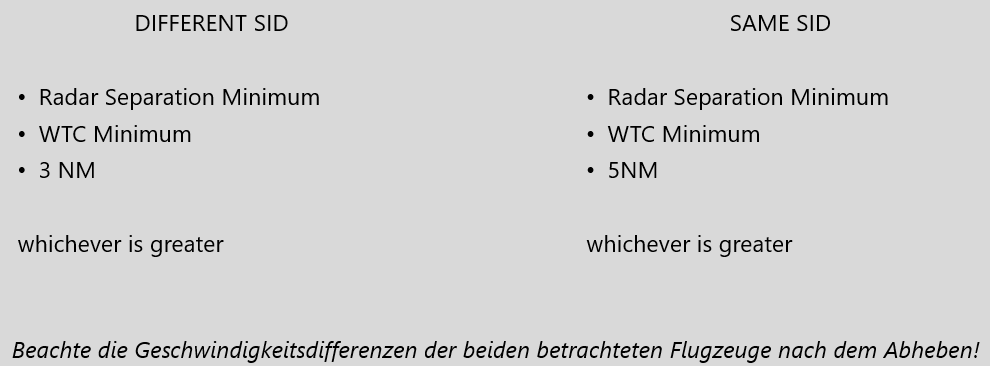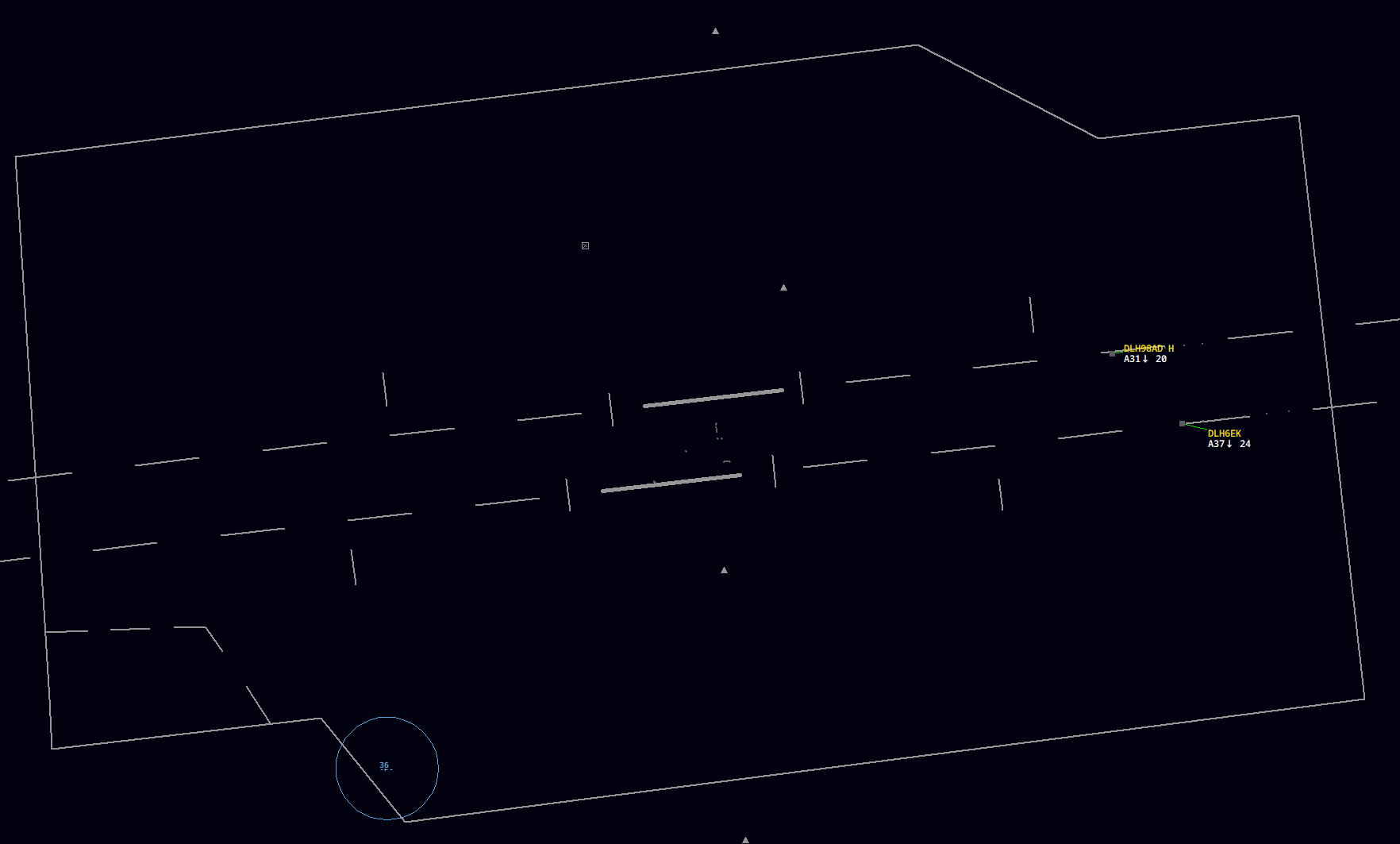Tower Separation
AllgemeinesGeneral
AlleAll voncontrol dertowers Deutschenoperated Flugsicherungby betriebenenDFS Kontrolltürme(German derAir internationalenTraffic VerkehrsflughäfenControl) at international airports (EDDx) habenhave eina Radarsystemradar system, überthat dascan gestaffeltprovide werdenradar darf.separation. DasThis klingtmight aufsound denobvious erstenat Blickfirst selbstverständlich,glance, istbut esit aberis nicht.not. InThere Deutschlandare gibtstill essome nochcontrolled einigeairports kontrolliertein Flugplätze,Germany, wiesuch z.B.as Mannheim oderor Karlsruhe, diewhich entwedereither keindo Radarnot habenhave oderradar derenor Flugsicherungspersonalwhose nichtair dafürtraffic ausgebildetcontrol ist,personnel mitare Radarnot zutrained staffeln.to Anuse diesenradar Plätzenfor wirdseparation. ganzAt konventionellthese aufairfields, Zeitthe gestaffeltconventional oderapproach dieis Staffelungseparated zwischenthrough timing or the separation between IFR An-arrivals undand Abflügendepartures wirdis delegated to the radar controller above.
Here you can see an denexample darüberliegendenof Radarlotsenthe delegiert.
Exemplarischsituation siehstradar duat hierMunich das Luftlageradar des Flughafens MünchenAirport (fürclick Vollbildfor klicken)full screen):
HierHere siehtyou mancan alsosee diethe entsprechendenlateral lateralenboundaries Grenzenof derthe KontrollzoneMunich München,control manzone, siehtyou can see the two runways in derthe Mittemiddle dieand beidendashed Pisten undlines in derentheir Verlängerungextension, gestricheltethe Linien,so-called die sogenannten extended centerlines.centerlines. EineEach Lückegap bzw.and eindash Strichon auf dieserthis extended centerline entsprechenequals jeweilsone einermile. Meile.Among Unterother anderemthings, damitthis istenables esus unsto möglich,measure Distanzendistances in derthe Kontrollzonecontrol abzumessenzone undand folglichtherefore dasuse Radarthe zuradar nutzen,to umcreate eineseparation. StaffelungOn herzustellen.the Auffinal demapproach Endanflugto der Pistenrunways 26L undand 26R26R, siehtyou mancan zweisee Radarzieletwo (Englisch: radar targets), dierepresenting zweitwo Flugzeugeaircraft. darstellen.Next Nebento demthe eigentlichenactual Radarzielradar befindettarget sichyou dassee sogenanntethe Labelso-called oderlabel Tag.or Diesetag. beidenThese Begriffetwo beschreibenterms diedescribe Informationenthe information (hier:here: Callsign,callsign, Groundgroundspeed speedand undaltitude) Höhe),provided dieto demthe Lotsencontroller vomby Radarsystemthe zurradar Verfügung gestellt werden.
system.
DieThe grundlegendebasic Mindeststaffelungminimum radar separation über Radar beträgtis 5 NM. BeiWith entsprechenderappropriate Radartechnikradar darftechnology, diesethis Staffelungseparation aufmay be reduced to 3 NM reduziert werden.NM. In DeutschlandGermany, istradar diecoverage Radarabdeckunghas inzwischenbecome sogood gut,good dassenough wirto nahezuallow überallus to operate at 3 NM separation almost everywhere (mitwith eina paarfew Ausnahmenexceptions in derthe Bremen FIR undand ganzin imthe Südenvery übersouth denover Alpen)the unterAlps) FL245below mitFL245. Consequently, 3 NM arbeitenis dürfen.also Folglichthe sindminimum auchvalue in deineryour Kontrollzone,control sofernzone duif dortyou überhave Radarstaffelungto angewandtuse werdenradar muss,separation 3 NM der Mindestwert.
there.
ZwischenBetween welchenwhich Flügenflights müssendo wirwe nunhave dieto Radarstaffelungensure sicherstellen?radar Dafürseparation? müssenTo wirdo wissen,this, we need to know which airspace class we are in. In the table in welcherthe Luftraumklasseairspaces wirchapter, unsthe befinden.third column of the table shows us who must be separated from whom. In deryour Tabelleairspace imas Kapitela Lufträumetower zeigtcontroller, uns die dritte Spalte der Tabelle, wer zu wem gestaffelt werden muss. In deinem Luftraum als Tower Controller, alsoi.e. D-CTR, mussyou nuronly zwischenneed IFR-Flügento gestaffeltseparate werden*IFR flights*. NähertFor sichexample, alsoif beispielsweisea einVFR VFR-Flugflight einemapproaches IFR-Flugan inIFR gleicherflight Höheat aufthe z.B.same altitude to within 1 NMNM, an,this sois istnot dasa "rule violation" in D-CTR kein "Regelverstoß".CTR. In Luftraumklasseairspace class C, on the other hand, this would be a "rule violation", as there (as you can see in the table) IFR must also be separated from VFR. This means that the approach controller in airspace C hingegenmust wäremake dassure einthat "Regelverstoß", da dort (wie du in der Tabelle sehen kannst) IFR auch zuevery VFR gestaffeltflight werdenis muss.at Das heißt, der Approach-Lotse muss in Luftraum C sicherstellen, dass jeder VFR-Flug mindestensleast 3 NM vonaway einemfrom IFR-Flugany entferntIFR ist.flight. DaHowever, dusince alsyou Towerlotseare abera einetower D-CTRcontroller betreust,in ist das für dich sehr komfortabel. "Regelverstöße" im Zusammenhang mit Staffelung nennt man übrigens Staffelungsunterschreitungen (STU) (Englisch: Losscharge of Separationa =D-CTR, LoS).this Dieseis STUsvery giltconvenient esfor unbedingtyou. zuThese verhindern,"rule daviolations" diesconnected einto sicherheitskritischesseparation Ereignisare istcalled und“loss of separation” or LOS (STU or STaffelungsUnterschreitung in derGerman). RegelThese beiLOSes einermust praktischenbe Prüfungprevented aufat VATSIMall zucosts, einemas Nichtbestehenthey führt.are safety-critical events and usually lead to a failing grade in a practical test on VATSIM.
*In derthe S2-Ausbildung2 lernsttraining duyou noch,will dassalso inlearn der Kontrollzone tatsächlich auch nochthat IFR zuto SVFR (Sonder-special VFR) gestaffeltmust werdenalso muss.be Weitere Infos dazuseparated in diesemthe undcontrol diesemzone. Artikel.More Fürinformation dieon S1-Ausbildungthis istin dasthis aberand nochthis nichtarticle. verpflichtendHowever, anzuwenden,this umis esnot nichtyet zumandatory komplexfor zuS1 machen.training so as not to make it too complex.
AbflügeDepartures
As
If
RadarstaffelungRadar separation (immeralways 3 NM)WirbelschleppenstaffelungWake turbulence separation (4 - 8 NM)- Departure Spacing (
individuellerindividualWert)value)
heranziehen.
RadarstaffelungRadar separationist, therefore, always is the minimum between two IFR aircraft. Depending on the constellation of wake turbulence categories you may also immerhave dasto Minimum zwischen zwei IFR-Fliegern. Je nach Konstellation der Wirbelschleppenkategorien musst du auch nochkeep Wirbelschleppenstaffelungwake turbulence separationbeachten.. Details zuon denthese Wertenvalues findestcan dube imfound entsprechendenin Artikel.the corresponding article.
DochBut waswhat ist nun einis Departuredeparture Spacingspacing? ManchmalSometimes erfordernlocal lokaleprocedures Verfahren,require dassmore manspacing mehrthan Abstandseparation braucht,actually alsprescribes. dieOne Staffelungexample eigentlichis vorschreibt.departures Einon Beispielthe sind Abflüge auf gleichensame SIDs:
AlsAn zusätzlicheadditional Anforderungrequirement fürfor dasdeparture Departurespacing Spacingmost giltairports anrequire dena meistenminimum Flughäfen:spacing between consecutive departures on the Gleichesame SIDsSID hintereinanderof brauchen mindestensleast 5 NM (Einzelheitensee dazuyour intraining derairport's SOP deinesfor Ausbildungsflughafens)details).
WährendWhile Separationseparation alsoalways immerdescribes dasthe absolute Minimumminimum, beschreibt,spacing sois ista Spacingvalue einthat Wert,is deralways immerat größerleast oderequal gleichto desor Staffelungsminimumsgreater istthan undthe einenseparation optionalenminimum Aufschlagand enthält.includes an optional safety margin.
MathematischIn ausgedrückt:mathematical terms: Spacing = Staffelungsminiumseparation minimum + optionaleroptional Aufschlag.safety margin.
AuchThe vomapproach Approach-or odercenter Centerlotsencontroller kannmay also specify a departure spacing in Einzelfällenindividual eincases Departureif Spacingthe vorgegebenairspace werden,is wennvery derfull. Luftraum gerade sehr voll ist. Hier kann auch einAn MDI, alsoi.e. Minimum Departure Interval, meistusually ausgedrücktexpressed in Minutenminutes, auferlegtcan werden.also Wennbe esimposed beispielsweisehere. heißtWith the restriction "MDI CINDY 5 Minutes"minutes", darffor derexample, Towerlotsethe alletower Departurescontroller nachmay allow departures to waypoint CINDY nuronly mitwith eineman Abstandinterval vonof at least 5 Minutenminutes.
To lassen.summarize, here is a short workflow that quickly and easily provides you with the correct minimum distance between two departures. Ideally and in the spirit of proactive controlling, you should not wait until the two aircraft concerned are already at the holding point to go through this flow. Do it as early as possible. Example: I give two pilots a clearance for pushback at the same time and already simultaneously consider what departure spacing will later be required on the runway. Everything that has already been planned only needs to be put into action and you have capacity for other things.
If your aircraft are on different SIDs, move to the left half of the table and go through the three bullet points: Radar Separation is always 3NM (on both sides). The largest value of the three bullet points is your minimum departure spacing.

|
Beispiel:
|
DuYou weißtnow nunknow Bescheid,which constellation commands how much separation. But when can you give the takeoff clearance to the rear pilot in welchertwo Konstellationtakeoffs? duWhen wievielthe Abstandrequired brauchst.separation Dochis wannachieved? kannstNo, duearlier beithan zweithat, Abflügenbecause dem hinteren die Takeoff-Clearance geben? Wenn die benötigte Staffelung erreicht ist? Nein, schon eher. Dennthe dieradar Radar-or oderwake Wirbelschleppenstaffelungturbulence mussseparation zumust dembe Zeitpunktensured gegebenat sein,the wenntime derwhen hinterethe Fliegerfollowing aircraft goes airborne geht. DaHowever, abersince zwischenthe demfront Aussprechenaircraft deralso Takeoff-Clearancecovers unda demcertain Abhebendistance desbetween hinterenthe Fliegersissuance derof vorderethe Fliegertakeoff jaclearance auchand einethe gewissetakeoff Distanzof zurücklegt.the kannstfollowing duaircraft, dieyou Takeoff-Clearancecan schonissue eherthe geben.takeoff Alsclearance earlier. As a Faustformelrule of thumb kannfor manaverage fürairliners, durchschnittlicheyou Airlinercan sagen,say dassthat dietakeoff Startfreigabeclearance etwamay be given about 1 NM vorbefore derthe benötigtenrequired Staffelungseparation. ausgesprochenSo werdenif darf.you Wenn duneed 3 NMNM, benötigst,you kannstcan dugive alsothe beitakeoff clearance at 2 NMNM. dieFor Takeoff-Clearance geben. Bei einera 4 km langenlong Pisterunway, entsprichtthis dascorresponds knappto demjust Pistenende.under the end of the runway.

DLH3TK hathas dasreached Pistenendethe erreichtend undof the runway and ACA841 bekommtreceives diethe Takeoff-Freigabe;takeoff derclearance; Abstandthe beträgtdistance is 2.1 NM, alsojust knappunder 1 NM wenigerless alsthan diethe benötigterequired Staffelungseparation

Ergebnis:Result: DieThe Fliegeraircraft gehengo mitairborne etwaswith alsa distance just over 3 NM airborne - optimaleoptimum Staffelungseparation
WICHTIG:IMPORTANT: BedenkeAlways auchbear immerin diemind the unterschiedlichendifferent Geschwindigkeitenspeeds imon Abflug.take-off. HastIf duyou vornehave einea C172 undlead hinten einenan A380 aufon einera unterschiedlichendifferent SID, soyou dürftestcould dutheoretically theoretischseparate them by 3 NMNM. machen.It Dassshould dasbe keinenlogical Sinnthat macht,this solltedoes logischnot sein,make dasense, deras the A380 mindestensflies doppeltat soleast schnelltwice fliegtas alsfast dieas the Cessna undand dementsprechendtherefore, beiat 3a NM3NM schonseparation kurza daraufLOS einewill Staffelungsunterschreitungdefinitely auftritt.occur shortly after takeoff.
In solchensuch Fällencases (hintererfollowing Abflugdeparture deutlichsignificantly schnellerfaster alsthan vordererleading Abflug)departure), istit esis ratsam,advisable dento schnellenflip Verkehrthe alsdeparture Nummersequence 1and startenlet zuthe lassenfast undtraffic somittake dieoff Abflugreihenfolgeas zunumber drehen.1. SieheSee auchalso Artikelthe Effizienzarticle imEfficiency Towerbereich.in Istthe diestower nichtarea. möglich,If undthis duis musstnot einenpossible schnellenand Abflugyou hinterhave einemto langsamensend Anfluga rausschicken,fast sodeparture koordiniereout denafter Zeitpunkta desslow Abflugsapproach, mitcoordinate the timing of the departure with Approach. ErThey hathave diethe Möglichkeit,option dasof Problemsolving mithilfethe vonproblem taktischenby Vektorentactically oderusing verschiedenenvectors Höhenor zudifferent lösenaltitudes undand sollshould dirlet Bescheidyou geben,know wannwhen duyou dencan schnellsend folgendenthe Abflugfast aufdeparture dieon Reiseits schicken kannst. way.
AußerdemYou sollteshould auchalso beipay attention to the initial rate of climb of the leading departure for "normalen"normal" Airlinernairliners. aufEspecially dieon initialethe Steiggeschwindigkeitnetwork, desthere vorderenare Abflugspilots geachtetwho werden.fly Vorunrealistically allemfast aufor dem Netzwerk gibt es Piloten, welche unrealistisch schnell oder langsam fliegen. Dieser Faktor sollte ebenfalls mit einkalkuliert werden.slow.
GenerellIn gilt:general, Bistif duyou dirare beinot irgendeinersure Sacheabout nichtsomething, sicher,always frageask. immerEspecially nach.the Geradecolleagues die Kollegen aufon APP undand CTR habenusually meisthave mehrmore Erfahrungexperience undand helfenwill dirbe gerne!happy to help you
AnflügeInbounds
The
The approach controller is responsible for the separation between approaches until the runway threshold is crossed. At international airports (EDDx), however, you as the tower controller may "save" the separation with the help of speed restrictions if you notice that without them, a LOS would become probable. You can also use speed instructions to maintain a gap for a VFR pilot, for example. However, it is important to coordinate speed instructions with the approach controller if there is another aircraft behind the aircraft with the assigned speed.
If two approaches are so sollstclose duthat ihmthere sois schnellstill wiea möglichrisk dieof Landefreigabea erteilen.loss Kommtof einseparation, Anflugyou undmust duinstruct hastone keinenof abfliegendenthe Verkehr,aircraft so(usually solltestthe dufollowing ihmone) demnachto direktgo beim initial call die Landefreigabe geben. Der Pilot muss seinearound Landefreigabebefore(!) spätestensthe vorloss demof Überfliegenseparation deroccurs. PistenschwelleIn erhaltenaddition, haben.traffic Hatinformation erabout dortthe keinetraffic Freigabe,concerned socan wirdbe eruseful. selbstständigFurther durchstarten.information

